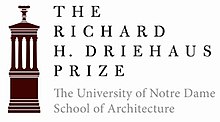Richard H. Driehaus Prize for Classical Architecture
| Driehaus Architecture Prize | |
|---|---|
 |
|
| Awarded for | A career of achievement in the art of classical architecture. |
| Sponsored by | The Richard H. Driehaus Charitable Lead Trust |
| Reward(s) | US$200,000 |
| First awarded | 2003 |
| Last awarded | 2015 |
| Official website | www |
The Driehaus Architecture Prize, fully named The Richard H. Driehaus Prize at the University of Notre Dame, is a global award to honor a major contributor in the field of contemporary vernacular and classical architecture, commonly referred to as New Classical architecture.
It was initiated by philanthropist Richard Driehaus and established in 2003 by The Richard H. Driehaus Charitable Lead Trust. It is presented annually through the Notre Dame School of Architecture, a faculty of the University of Notre Dame in Indiana, United States. The Driehaus Prize is an alternative to the predominantly modernist Pritzker Prize.
The most recent winner is 2017 laureate Robert Adam of ADAM Architecture, who will officially be awarded on March 25 in Chicago.
The Driehaus Prize is awarded to a living architect whose work embodies the principles of traditional and classical architecture and urbanism in contemporary society, and reflects what the jury considers positive cultural, environmental and artistic impacts. The award itself is a bronze miniature of the Choragic Monument of Lysicrates, known as the first use of the Corinthian order on the outside of a building. The award includes a monetary prize of US$200,000.
The Henry Hope Reed Award is given in conjunction with the Driehaus Prize to an individual working outside the practice of architecture who has supported the cultivation of the traditional city, its architecture and art through writing, planning or promotion.
A panel of distinguished jurors selects one architect who has greatly influenced the field of traditional and classical architecture to receive the Richard H. Driehaus Prize at the University of Notre Dame. The jury travels together to a city of architectural significance, exploring it together, and taking the city’s urban fabric as a backdrop for its deliberations.
...
Wikipedia
